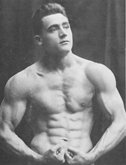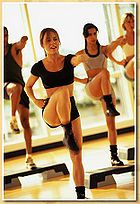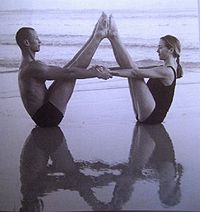Exercise
 From Conservapedia
From Conservapedia 
Exercise is bodily or mental exertion, especially for the sake of training or improvement of health.
Exercise can also refer to the using of a power or right. Example: The president exercised executive privilege in the dispute.
Contents
- 1 Health
- 2 Injuries
- 3 Fitness
- 4 Researchers
- 5 See also
- 6 External links
- 7 References
Health[edit]
How to achieve radiant good health through exercise and natural means was Bernarr Macfadden's central message throughout his entire life. [1]
- Exercise is health!
“There’s no medicine that’s more important than exercise,” Daniel Lieberman, chair of Harvard's Human Evolutionary Biology Department.
Movement-cures, on the other hand, reveal their benefit after the end of a week or so—at first by improvements in the facility of the exercise itself, but soon also by indisputable physiological changes for the better. The appetite revives, sleep becomes quieter and more protracted, till the depressing feeling of helplessness gives way to the buoyancy of self-confidence. [2]
Lack of activity destroys the good condition of every human being, while movement and methodical physical exercise save it and preserve it. Plato.
Injuries[edit]

Consult your physician before beginning any exercise program. Be careful with your exercise goals and always warm up and cool down.
Most people know about runner’s high. But for most runners, injury is as much a part of the experience as euphoria. Studies vary widely, but it is estimated that between 30 and 80 percent of regular runners are injured in a given year. Shin splints, runner’s knee, iliotibial band syndrome, plantar fasciitis: For many years, everyone from coaches to biologists to casual joggers has accepted such injuries almost as a necessary evil... But a growing number of researchers, many of them at Harvard, are convinced it doesn’t have to be that way.[1]
Avoid high-impact aerobics. Most aerobics instructors and many students suffer injuries to their shins, calves, lower back, ankles, and knees because of the repetitive, jarring movements of some aerobics routines. If you have continuing pain during an exercise, stop and don't continue unless you can do so painlessly. Replace fluids lost through sweating.[2]
Fitness[edit]

Of all the ways to stay fit, walking is the easiest, safest, and cheapest. It can also be the most fun.[3] In fact, walking and running the same distance will consume about the same amount of calories.[4] Excellent "aerobic" activities for building endurance include brisk walking, running, in-line skating, swimming, cycling, rowing, and aerobic dance. Recommendation: To gain health benefits, 30 minutes of moderate physical activity over the course of most days is enough.[5] Keeping an accurate progress diary during your training years is imperative. Without a physical assessment and a workout diary, one can never be sure if the path taken will lead you to the promised body. Results must be measured or quantified before and after start exercising.[6]
Combining aerobic and anaerobic exercise is essential to maintaining overall balanced fitness. While most associate getting into shape with aerobic activities, anaerobic exercise is a beneficial complement to aerobic exercise. Specific types of anaerobic exercise include tennis, weight lifting, sprinting and jumping.[7]
Researchers[edit]
The benefits of exercise have been exposed since ancient Greece (Plato), and Marcus Cicero. Scientifically, since 1949 a team led by Jerry Morris (a Scottish, 1910 – 2009) established the importance of exercise. Morris is known as "The man who invented exercise".[8]
Science writer Jörg Blech has set out the actual physiological effects of exercise.
Exercise triggers the growth of new brain cells, induces stem cells in blood vessels, and reverses symptoms of heart disease and type 2 diabetes. Doctors are now using exercise to combat common ailments such as heart disease, arthritis, diabetes, osteoporosis, and depression. [9]
"Healing through Exercise: Scientifically-Proven Ways to Prevent and Overcome Illness and Lengthen Your Life" by Jorg Blech is a book dense with medical studies. Ibidem
Dr. Jeffrey R. Stout, an assistant professor at Creighton University, has over 70 published manuscripts and abstracts; he wrote: The Scientifically Proven Approach to Exercise.[10]
Some scientific exercise training principles include: Individual differences cause different responses to an exercise program; increasing the workload or overload accordingly in order to improve fitness, strength or endurance; progression or gradual and systematic increase of the workload over a period of time will result in improvements in fitness without risk of injury; adaptation which refers to the body's ability to adjust to increased or decreased physical demands.[11] Building strength is one of the fastest ways to improve your sports performance and train more efficiently.[12]
See also[edit]
- Bernarr Macfadden
- Alois P. Swoboda
- Yoga
- Naturopathy
- Bodybuilding
- Sports, exercise and diet
- Stress
External links[edit]
- PHYSICAL CULTURE WITH RESISTING EXERCISES By Bernarr Macfadden.
- The Golden Age of Iron Men
- Health & Strength or Practical Athletics for Busy People Alex Whitely - 1891, Inventor of the Whitely Exerciser.
- GIMNASIA, ENERGIA Y SALUD. DR. ADRIAN VANDER In Spanish.
- Obesity? Diabetes? We’ve been set up. Harvard Science.
- Chasing down a better way to run.
- What's Good About Swimming.
- Fitness Fact or Fiction?
References[edit]
- ↑ http://news.harvard.edu/gazette/story/2012/04/chasing-down-a-better-way-to-run/
- ↑ http://www.wellnessletter.com/html/fw/fwFit01GetFit.html
- ↑ http://www.wellnessletter.com/html/fw/fwFit04Walking.html
- ↑ https://www.pickupbrains.com/health-and-fitness/facts-about-exercise-that-every-one-should-know/
- ↑ http://www.wellnessletter.com/html/fw/fwFit01GetFit.html
- ↑ http://www.healthfitness.com.au/articles/index.html
- ↑ http://www.healthycarebody.com/tag/exercises/
- ↑ When Was Exercise Invented?
- ↑ Healing through Exercise: Scientifically-Proven Ways to Prevent and Overcome Illness and Lengthen Your Life.
- ↑ The Scientifically Proven Approach to Exercise.
- ↑ Exercise Science Principles of Conditioning.
- ↑ How to Get Fit Fast - Tips for Effective Exercise and Workout Programs.
Categories: [Health] [Health Promotion]
↧ Download as ZWI file | Last modified: 02/16/2023 01:25:40 | 102 views
☰ Source: https://www.conservapedia.com/Exercise | License: CC BY-SA 3.0
 ZWI signed:
ZWI signed: KSF
KSF